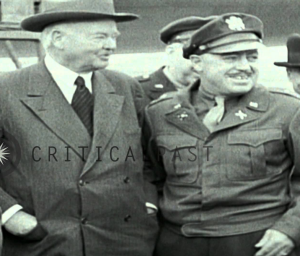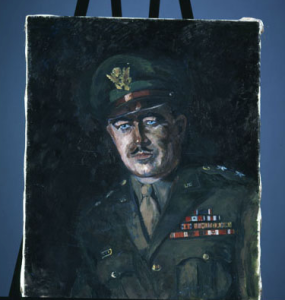
Japan’s financially intriguing – and criminal – history with the US and what Japan’s LDP (one party plutocracy) represents has led me to a 40 second video clip from the website Critical Past. I located this clip while trying to figure out why ex-President Herbert Hoover (his presidential term ended in 1933) flew all the way to Japan arriving May 5, 1946 at Atsugi, Japan to meet with Major General William Frederic Marquat. On arrival, Herbert Hoover was met on the tarmac at Atsugi, Japan by Major General William Frederic Marquat who was on General MacArthur’s GHQ staff in Tokyo then left together by car from Atsugi. The short video can be viewed below of Hoover’s arrival aboard a C-24 aircraft.
Three aspects on Herbert Hoover’s background which have been completely forgotten are key components I think as to why Herbert Hoover flew to Japan to meet with General William Marquat. The first is that Herbert Hoover was a professional mining engineer; second, Herbert Hoover was in Australia working in gold mines for the British-based mining company Bewick, Moreing & Co. beginning in 1897; third, Hoover was later appointed to head the Hoover Commission in 1947 by President Harry Truman. Another intriguing aspect is related to what is known as the M-Fund that was named after Major General William Fredric Marquat. It is alleged with a large amount of documented evidence that Japan’s LDP (one party plutocracy) has had access to this M-Fund (“Marquat fund”) for the past 71 years. This explains convincingly why Japan’s one party plutocracy has stayed in power all these years culminating today in the LDP’s Shinzo Abe as Japan’s Prime Minister. The M-Fund named after General William Marquat was based on gold pillaged out of Asia by the Japanese in Japan’s Operation Golden Lily overseen by Japan’s Prince Chichibu.
Although Wikipedia states the Hoover Commission was set up to “make administrative changes in the government for more efficiency”, that wasn’t the case. The National Security State was set up under President Truman in 1947 and Herbert Hoover’s job was to make that happen partially I think because of Hoover’s specialized background in gold mining as an engineer. A mining engineer appointed to make “government more efficient” (since when do governments want to become more efficient?) with a trip one year before he was appointed to head the commission in 1947 goes to Japan to meet General Marquat? Although there has been a lot of research over the years into the M-Fund, it is difficult obtaining evidence because under the National Security Act of 1947, the military archives from the 50s and 60s remain sealed. Marquat had no military experience being a reporter for the Seattle Times before the war even though he was on General MacArthur’s staff.
Herbert Hoover debarks from C-24, meet Major General William Fredric Marquat

General Marquat was pretty much of an outsider apparently, considering Marquat’s background who was later brought to General MacArthur’s headquarters in Tokyo from Bataan, Philippines (the Bataan Boys) by MacArthur. Marquat was working as an economics liaison officer between MacArthur’s GHQ headquarters and the newly formed Japanese government under Shigeru Yoshida. Marquat having a large ego it seemed, brought a painter with him and the painter was assigned to paint portraits of US military high command personnel assigned to MacArthur’s headquarters in Tokyo including Marquat’s own portrait. Reading his military career is pretty much boiler plate being decorated for distinguished service numerous times once at “great personal risk” for inspecting anti-aircraft installations during the Korean war.
Basically, just show up on a battlefield anywhere and you get one of those medals, especially if one of your fellow officers writes the award up for you. Marquat enlisted in the military during WWI and was assigned to a coastal artillery unit. Marquat joins the the military again this time showing up as an officer in the Philippines as a “coast artillery officer.” Outside of being in Japan after WWII ended and before that in the Philippines as the “chief artillery officer” with MacArthur before the Japanese showed up, he really doesn’t have a military career. There is no record of his military training, where he was trained and when he was commissioned. It’s like he gets picked up and delivered to General MacArthur for whatever his skills were at the time. While in the Philippines with MacArthur, Marquat was with the Office of Military Advisor to the Commonwealth Government of the Philippines, as the chief engineering advisor. Chief engineering advisor? A previous newspaper reporter with the Seattle Times with basically no solid military accomplishments under his belt except related to possibly pelting artillery shells is in the Philippines as an “engineering advisor”? Something does not add up here.
When the Japanese government was being set up through General MacArthur’s GHQ with General Marquat working as a liaison between Washington and Japan as chief of the Economic and Scientific Section (ESS), Japan’s Prime Minister Shigeru Yoshida was working to achieve Japan’s economic stabilization. In Secret Emissary by Kichi Miyazawa and Robert D. Eldridge, these authors stated Marquat always thought himself to be overly “self-important”, and that in the end Marquat wasn’t as important as he thought himself to be. So what was General Marquat really up to? From the historical material that is available, Marquat’s military career has been kept confidential other than a record of Marquat being involved with what was referred to as the Bataan Boys.
This is probably why in Kichi Miyazawa and Robert D. Eldridge’s book Secret Emissary, they had a hard time figuring out Marquat’s work at GHQ. Whatever his work was, it was important enough for Marquat to go to Atsugi to personally greet ex-President Herbert Hoover and escort him to GHQ in Tokyo. I suspect that because Marquat was always considered to be “an outsider” of the Bataan Boys, and because of his devotion to General MacArthur, the M-Fund (or the “Marquat Fund”) was named after him with Marquat being assigned the task with instruction from others more knowledgeable in economics than him, to facilitate the M-Fund. From an intelligence perspective this would provide good cover with Marquat himself not being completely articulate about the M-Fund. As the chief of ESS at GHQ in Tokyo, Marquat had to call in outside economic experts like Sherwood Fine and others to assist him. When Marquat retired, the US Government treated him very well which is worth noting. The Bataan Boys was the group of officers around MacArthur in the Philippines from 1935 on who formed a powerful group of military confidants.
The best summary of the M-Fund is the following which after initial reading seems rather dull and typical historical coverage. Another Marshall Plan this time to financially underwrite Japan’s reconstruction:
The new fund was administered by General MacArthur’s Headquarters with advisory input from Japanese sources, primarily Prime Minister Shigeru Yoshida. The fund came to be known to insiders as the “M-Fund” or “Marquat-Fund,” after an officer named Marquat who was identified with the fund’s establishment and early operation. Because of Mr. Yoshida’s involvement with the Fund, it has also sometimes been referred to as the “Yoshida Fund.” The M-Fund was used not only for the building of a democratic political system in Japan but, in addition, for all of the purposes for which Marshall Plan funds were used in Europe–in effect, the rebuilding of the Japanese economy. Long-term, low-interest or interest-free loans were provided to key Japanese industries such as coal, iron, shipbuilding, fertilizer, electric power, and the like.
You must be logged in to post a comment.